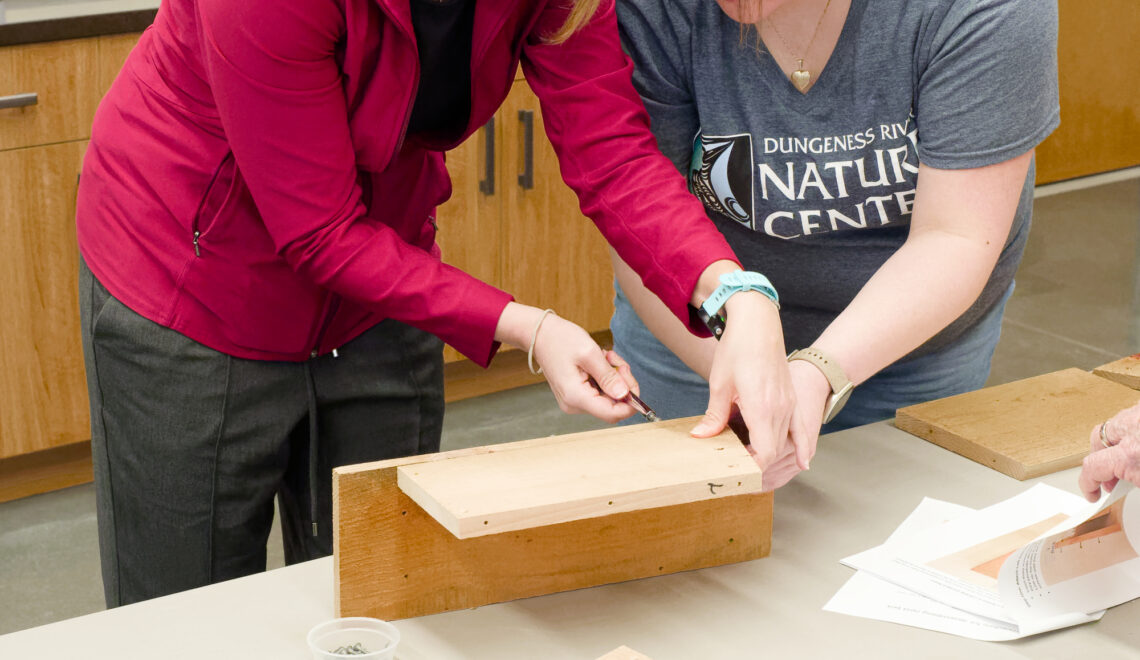
How to Build a Nesting Box
The partnership between the Olympic Peninsula Audubon Society (OPAS), and the River Center successfully began offering nest box building classes 22 years ago. Each year since, an OPAS team organizes and schedules the classes, to make full use of the Center’s facilities. The class starts with a short, informal presentation on local birds that nest in cavities and nest boxes. Presentation is followed by hands-on assembly by each attendee, of a nest box kit. OPAS volunteers help with assembly as needed, and attendees take home their own new box at the conclusion of the class.
If you were not able to participate in February 24th class, no need to worry! Another nest box building class will be offered as part of BirdFest 2024, on April 13th at 10 a.m. Keep in mind that spaces and precut kits are limited, and class may fill well before the class date. Register early to save your space.
Which birds benefit from nesting boxes?
What qualities make a good nesting box?
Why are they important?
Did you know that only 10% of birds nest in cavities or nesting boxes? The other 90% of bird species build their own nests in a variety of places, ranging from trees, to bushes, to beaches, to cliffsides. Here in Sequim, we host various cavity nesting bird species including: Red-breasted Nuthatch, Chestnut-backed Chickadee, Black-caped Chickadee, Tree Swallow, and Violet-green Swallows.
Due to a combination of causes including — loss of nesting habitat, competition for nest cavities from introduced bird species, climate change, and diminished food sources, many of our native and migratory cavity nesting birds have lost their nesting habitat. By building nesting boxes and placing them around our community, we help replace some of their lost cavities. Through the use of nest boxes, we attract birds to nest in safer places to raise their young. In addition, the boxes allow us to observe and learn more about bird nesting and breeding behavior. It’s fun!
When building a nesting box, certain criteria should be met depending on which species you aim to attract. First off, it is important to identify which habitat that your chosen bird species requires for their nests. From there, you can survey potential areas around your home that may be suitable for a nesting site.
When constructing your nest box, the size of the entry hole is important. If the hole is too small for your intended bird species, they won’t be able to access the nesting box. However, if the hole is too large, it can allow larger birds to take over the nest or expose the nest to predators.
Another surprising factor that creates an unsafe nesting environment are roost pegs! Even though it’s common to see pegs on many examples of bird houses, roost pegs are dangerous. They provide predatory birds a perch for easy access to the nest box. This can jeopardize the lives of young birds.
When choosing materials for the box, it is best to use rough cut natural wood. OPAS tends to use cedar, a native tree to the Olympic Peninsula. Chemicals in treated woods, and resins in manufactured wood (such as particleboard or plywood) pose a threat to the health of nesting adult birds, but especially to hatchlings. While decorating or painting a nesting box is not recommended, non-toxic stains or latex based paints may be applied to the exterior of the box. The interior of the box and the entry holes are best left as natural, rough cut wood.
If you aim to attract to swallows to the boxes made in the class, it is important to place them in an open area. Swallows like to breed and feed in fields usually adjacent to or near fresh water. This location will also prevent any branches or debris from falling and causing damage to the box. We recommended placing the nest box facing southeast, south, or southwest so that the opening is exposed to the warm spring and summer sun. We also advise so that the opening is faced away from the prevailing winds during the spring and summer seasons. It’s enjoyable to have more than one nesting box, since swallows tend to nest around one another. So long as you have 12-15 ft between the boxes, the swallows will not mind having company!
Nesting boxes can last for many years, and many nesting seasons. It is important that before each season, you check on your nesting boxes to ensure that they are clean, insect free, and ready for the next occupants. You may find that birds have expanded the entry hole to be larger than the design size. It may then be necessary to replace the hole protector before the new season. Please inquire at the Center’s gift shop to obtain a replacement, or get plans to make your own.
Although the Center’s nest box classes are classes are only offered in late winter and early spring, you can make a nesting box any time of the year. Building your own box can be a fun experience to enjoy with your family or friends, and a rewarding way to connect with nature! You can use the boxes you build in this class as a pattern to build your own. We’re here to consult and advise you.

